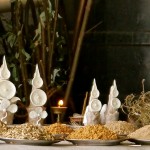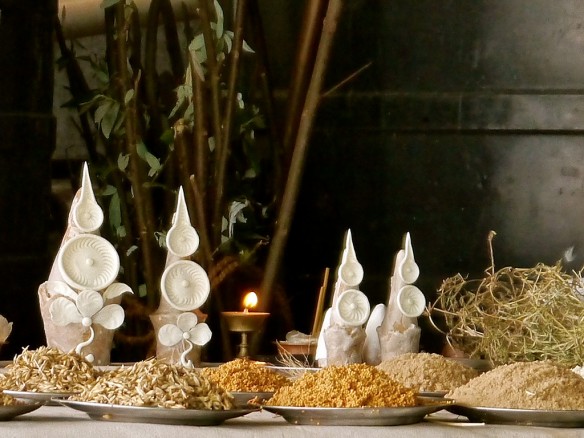Although these figures may use different words to express their ideals and look after separate communities, they all share one thing in common. They do not live for themselves.
In the eight months that I have spent in India so far this year, I have encountered a number of modern day gurus. I stumbled across the Karmapa’s Kagyu Monlam in Bodhgaya, served others alongside Swami Asimatmananda in Chapra, felt the warmth of Amma’s embrace in Delhi, and watched the transformation of Maharaj Yadneshwara in Beed. Although these figures may use different words to express their ideals and look after separate communities, they all share one thing in common. They do not live for themselves. The lives of the Karmapa, Asimatmananda, Amma, and Yadneshwara are dedicated to serving living beings and helping them to fully develop their humanity. Toward this end, each of them supports an educational institution: the Karmapa International Buddhist Institute, Ramakrishna Mission’s school for poor children, Amma’s Amrita University, and Yajneshwara’s traditional Vedic gurukula.
In December, his Holiness the Karmapa led the Kagyu Monlam in Bodhgaya, where he taught about Bodhisattva Samantabadra’s prayer for excellent conduct. The event brought together people from all over the world who strengthened their resolve for awakening. After a couple from Germany guided me to the prayer site, Lamas came around with hot butter tea and steamed bread to make sure all the guests were comfortable. The ancient Mahābodi Temple came alive with color, lights, and hospitality. The merit generated from this practice is thought to pacify disasters and remove obstacles not only for those to take part in the Monlam, but for all living beings.
He offers people dignity and hope. He shines as a bright light in a grim environment full of hardship, povery, and crime.
Even though Swami Asimatmananda is in charge of the ashram that runs his charity school and hospital, he is most often found serving others. In fact, his motto is to serve others always and to make them happy. He gives much of his time, energy, and material resources to one of the poorest communities in India. In doing so, he also offers people dignity and hope. He shines as a bright light in a grim environment full of hardship, povery, and crime. Most people would fly this coop as quickly as possible, but Swami Asimatmananda has made Chapra his home for many years, serving others with the same devotion he offers his devatā. His spiritual practice emulates the bodhisattva resolve.
In January Amma toured India, sitting for hours at a time to ensure that everyone who wished to receive darśan would get a hug. Though she had been sitting all day, she did not tire of holding each person close to her heart for a few seconds while chanting a mantra. Considered a māhātmya by her devotees, she shares a taste of her immense śakti energy with people all over the world. I took note of the energetic calm and kindness that permeated the environment at Amma’s event.
Like his father before him, Maharaj Yadneshwara is a yajamāna, or institutor of the yajña. Early European scholars translated yajña as sacrifice, but this word fails to capture the scope of the original Sanskrit. A yajña is an offering not only to the devas (those beings full of light), but to all who participate, even as a mere spectator. It is a religious performance meant to advance and purify the practitioner’s mind by demanding incredible personal sacrifice. The yajamāna and his wife eat only a small serving of fresh milk and curd twice a day for the duration of the yajña—in this case 16 days. In this condition, they lead the ritual performance, which requires steadfast attention and constant prayer to honor the limitless capacity of the devas before them, inviting these energetic, radiant beings to the consecrated space.
In this way, a bodhisattva can serve people from where they stand, without friction between limited perspectives. Such an orientation saves a lot of energy.
This space, of course, is a symbol of the human body, which becomes cleansed and filled with light. At random times, the Maharaj and his wife step outside the sacrificial enclosure to entertain long lines of people waiting to bow at their feet in respect for their undertaking, the performance of which is intended, as declared at the beginning of the yajña, to benefit all living beings. Despite all the attention, Maharaj demonstrated great patience without asserting self-importance. Perhaps for this reason, throngs of volunteers come together to donate their time and resources, giving to Agni and Indra as well as to each other in an effort to draw near to the goal of Vedic life.
It was at Yadneshwara’s soma-yajña that I was tested to see whether I have what it takes to be a Bodhisattva. Normally it is not a big deal to be a foreigner in India, but the people in Beeḍ had not seen a foreigner in four or five years. I became a kind of celebrity upon arrival, being interviewed and photographed by local newspapers and swamped by yajña onlookers, curious to practice the English they learned in school or introduce me to their families in Hindi and Marathi. I had no space to myself, and quickly tired of their repetitive, mundane questions. They took my photograph, constantly asked whether I had eaten, and awkwardly requested my autograph.
A thousand hands stretched out to help others, and I crouched in fear of a few curious spectators. Still so much to learn…
What was irritating was that each one wanted a bit of my attention. The schoolgirls beamed when I spoke to them. But there was an uncomfortable tension between their self-reference, including the strange connection projected onto me, and my experience. I could not empty myself out to accept their position, but clashed against it, trying desperately to convince them that I’m an unimportant student. By the end of the yajña, I realized that a bodhisattva has emptied out his or her ego and self-projections, and so he or she does not shelter any constructed self-identity against the projections of others.
In this way, a bodhisattva can serve people from where they stand, without friction between limited perspectives. Such an orientation saves a lot of energy. During the last few days of the yajña, I tried my best to smile, be kind, and respond to the many people who called out to me or broke into the sacrificial enclosure to meet me. After all, they only wanted recognition. How much more does a bodhisattva give to help free living beings from saṃsāra? A thousand hands stretched out to help others, and I crouched in fear of a few curious spectators. Still so much to learn…



